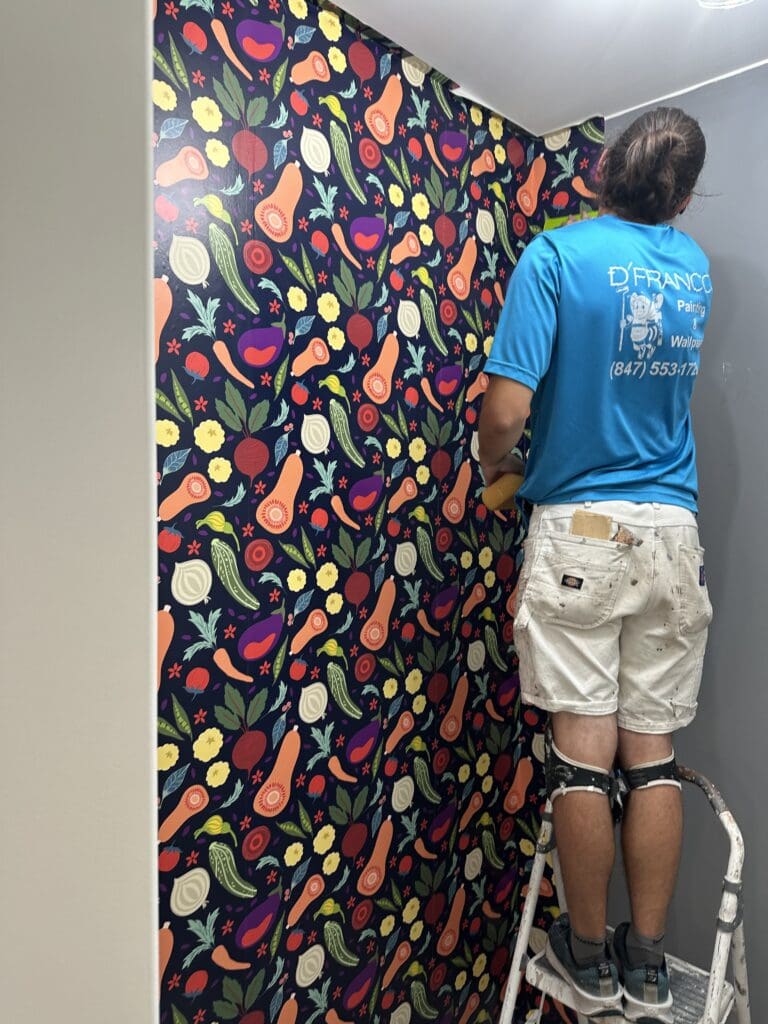Top Issues with Peel and Stick Wallpaper
Peel-and-stick wallpaper has become a popular choice for homeowners who want a quick and easy way to update their spaces without committing to traditional wallpaper. It’s marketed as a simple, hassle-free option, but if you’ve tried it—or are thinking about it—you might have a few concerns. These concerns are valid- cause as a wallpaper installation company we have the stuff! So-If you’re facing problems with peel-and-stick wallpaper, you’re not alone. Here are the Top Issues With Peel and Stick Wallpaper we see, hear or have to deal with.
“Peel and stick Wallpaepr Won’t Stick Properly!”
This is one of the most common frustrations with Peel and Stick Wallpaper. You peel back the wallpaper, smooth it down, but within hours or days, it starts bubbling up or peeling off from the corners.

Why This Happens: Peel-and-stick wallpaper struggles to adhere to certain surfaces, such as heavily textured walls or those with matte, VOC or low-sheen paint. The surface might not be clean enough, or moisture could be affecting the adhesive. (it also could be junk paper)
How to Fix It:
- Surface Prep: Make sure your walls are clean and dry before applying the wallpaper. Use a mild detergent or wipe with rubbing alcohol to ensure no dust or residue remains.
- Compatibility Check: If you have textured walls, test a small piece before applying a whole sheet. Some brands work better with slightly textured walls, while others might only be suitable for smooth surfaces.
- Apply Heat: For stubborn edges, use a hairdryer on a low setting to gently heat the adhesive while smoothing it down.
My wallpaper is Bubbling
You’ve done everything right, but unsightly bubbles appear under your wallpaper, making it look uneven and poorly applied.
Why This Happens: Bubbles occur when air gets trapped underneath the wallpaper or when the wallpaper isn’t smoothed out evenly during application.- or the same reason it s not sticking as above contributes to bubbles!
How to Fix It:
- Work Slowly: Peel the backing off gradually while smoothing the wallpaper with a squeegee or flat edge as you apply it. This reduces the chance of air pockets forming.
- Pop the Bubbles: If bubbles still appear after application, use a sharp pin or needle to poke a tiny hole, then smooth out the air with a squeegee.For larger air pockets, peel back the wallpaper from the nearest corner and reapply, smoothing as you go.
It can be incredibly frustrating when your wallpaper tears as you’re trying to line it up or adjust it. Thin wallpaper materials are especially prone to ripping, which can ruin the look and waste money. Take a look at our FAQ on wallpaper
The Wallpaper Tears During Application
Why? Like a bird-Cheap..cheap..cheap. Low-quality peel-and-stick wallpaper often tears more easily than thicker, higher-quality options.
- Invest in Quality: Higher-quality wallpaper will be thicker and more durable. It may cost a little more upfront, but it will save you time, effort, and frustration in the long run.
- Work with Care: Take your time when applying the wallpaper, especially if you need to reposition it. Tugging too hard can lead to rips.If your wallpaper does tear, use a matching paint or patch kit to fill in the gaps. Depending on the pattern, you may also be able to overlap the tear slightly.
Why is the Peel and Stick Wallpaper runing my walls?
Peel-and-stick wallpaper is marketed as easily removable, but what if it doesn’t come off without leaving a sticky residue—or worse, pulling off some of the paint or drywall?
Why This Happens: If the wallpaper has been applied for a long time, if the adhesive was too strong, or if the walls were not painted the right way previously- you might run into trouble removing it without damage.
How to Fix It:
- Remove Slowly: When removing peel-and-stick wallpaper, pull it off slowly and at a sharp angle. Ripping it off quickly can damage the wall.
- Use Heat: Just like during application, a hairdryer can soften the adhesive, making it easier to remove.If you’re left with sticky residue, rubbing alcohol or a gentle adhesive remover should take care of it without damaging the walls.
Other Peel and stick Thoughts
Peel-and-stick wallpaper can be a fun, easy way to update a room, but it’s not without its challenges. From peeling to bubbling, knowing how to handle these common issues can save you time and effort. And if you need more detailed information on how to remove wallpaper or tips on applying wallpaper in tricky areas like bathrooms, check out our other blog posts on D’Franco Painting and Wallpaper for additional resources and expert advice.


